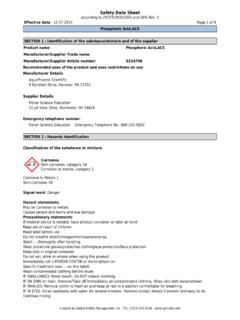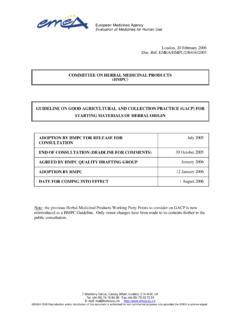Transcription of Keys to Soil Taxonomy - USDA
1 United StatesDepartment of AgricultureKeys toSoil TaxonomyTenth Edition, 2006 keys to soil TaxonomyBy soil Survey StaffUnited States Department of AgricultureNatural Resources Conservation ServiceTenth Edition, 2006iiThe Department of Agriculture ( usda ) prohibits discrimination in all its programsand activities on the basis of race, color, national origin, age, disability, and where applicable,sex, marital status, familial status, parental status, religion, sexual orientation, geneticinformation, political beliefs, reprisal, or because all or a part of an individual s income isderived from any public assistance program.
2 (Not all prohibited bases apply to all programs.)Persons with disabilities who require alternative means for communication of programinformation (Braille, large print, audiotape, etc.) should contact usda s TARGET Center at(202) 720-2600 (voice and TDD). To file a complaint of discrimination, write to usda ,Director, Office of Civil Rights, 1400 Independence Avenue, , Washington, 20250-9410 or call (800) 795-3272 (voice) or (202) 720-6382 (TDD). usda is an equal opportunityprovider and : Profile of a shallow Udipsamment with an abrupt wavy boundary between the C horizon andbedrock.
3 Depth to paralithic contact is 14 to 20 inches. Photo by John Kelley, soil Scientist, Raleigh, of ContentsForeword .. vChapter 1: The Soils That We Classify .. 1 Chapter 2: Differentiae for Mineral Soils and Organic Soils .. 3 Chapter 3: Horizons and Characteristics Diagnostic for the Higher Categories .. 5 Chapter 4: Identification of the Taxonomic Class of a soil .. 31 Chapter 5: Alfisols .. 35 Chapter 6: Andisols ..77 Chapter 7: Aridisols ..97 Chapter 8: Entisols ..123 Chapter 9: Gelisols.
4 143 Chapter 10: Histosols ..153 Chapter 11: Inceptisols .. 159 Chapter 12: Mollisols .. 191 Chapter 13: Oxisols ..235 Chapter 14: 251 Chapter 15: Ultisols .. 261 Chapter 16: Vertisols ..283 Chapter 17: Family and Series Differentiae and Names .. 295 Chapter 18: Designations for Horizons and Layers .. 317 Index .. 325vForewordThe publication of this edition of keys to soil Taxonomy (the 10th edition) coincides withthe 18th World Congress of soil Science, to be held at Philadelphia, Pennsylvania, in July2006. The last time the World Congress was hosted in the United States was in 1960 atMadison, Wisconsin.
5 At that time, soil Classification: A Comprehensive System, 7thApproximation was released for review and testing. The classification system was officiallyadopted for use in the United States soil survey program in 1965. The first edition of SoilTaxonomy: A Basic System of soil Classification for Making and Interpreting soil Surveyswas published in 1975. Over the years soil Taxonomy has been modified and expanded toreflect our increased knowledge of the world s soils. After the first eight editions of the Keysto soil Taxonomy were released, the second edition of soil Taxonomy was published in then, the 9th edition of the keys was published in 2003, and now this 10th edition publication keys to soil Taxonomy serves two purposes.
6 It provides the taxonomickeys necessary for the classification of soils in a form that can be used easily in the field. Italso acquaints users of the taxonomic system with recent changes in the system. This editionof the keys to soil Taxonomy incorporates all changes approved since publication of the ninthedition in 2003. We plan to continue issuing updated editions of the keys to soil Taxonomy aschanges warrant new authors of the keys to soil Taxonomy are identified as the soil Survey Staff. Thisterm is meant to include all of the soil classifiers in the National Cooperative soil Surveyprogram and in the international community who have made significant contributions to theimprovement of the taxonomic L.
7 GoldenDirector, soil Survey DivisionNatural Resources Conservation Service1 SOIThe word soil , like many common words, has severalmeanings. In its traditional meaning, soil is the natural mediumfor the growth of land plants, whether or not it has discerniblesoil horizons. This meaning is still the common understandingof the word, and the greatest interest in soil is centered on thismeaning. People consider soil important because it supportsplants that supply food, fibers, drugs, and other wants ofhumans and because it filters water and recycles wastes.
8 Soilcovers the earth s surface as a continuum, except on bare rock,in areas of perpetual frost or deep water, or on the bare ice ofglaciers. In this sense, soil has a thickness that is determined bythe rooting depth of in this text is a natural body comprised of solids(minerals and organic matter), liquid, and gases that occurs onthe land surface, occupies space, and is characterized by one orboth of the following: horizons, or layers, that aredistinguishable from the initial material as a result of additions,losses, transfers, and transformations of energy and matter orthe ability to support rooted plants in a natural definition is expanded from the 1975 version of SoilTaxonomy to include soils in areas of Antarctica wherepedogenesis occurs but where the climate is too harsh tosupport the higher plant upper limit of soil is the boundary between soil and air,shallow water, live plants.
9 Or plant materials that have not begunto decompose. Areas are not considered to have soil if thesurface is permanently covered by water too deep (typicallymore than m) for the growth of rooted plants. Thehorizontal boundaries of soil are areas where the soil grades todeep water, barren areas, rock, or ice. In some places theseparation between soil and nonsoil is so gradual that cleardistinctions cannot be lower boundary that separates soil from the nonsoilunderneath is most difficult to define. soil consists of thehorizons near the earth s surface that, in contrast to theunderlying parent material, have been altered by the interactionsof climate, relief, and living organisms over time.
10 Commonly, soil grades at its lower boundary to hard rock or to earthymaterials virtually devoid of animals, roots, or other marks ofbiological activity. The lowest depth of biological activity,however, is difficult to discern and is often gradual. Forpurposes of classification, the lower boundary of soil isarbitrarily set at 200 cm. In soils where either biological activityor current pedogenic processes extend to depthsgreater than 200 cm, the lower limit of the soil for classificationpurposes is still 200 cm. In some instances the more weaklycemented bedrocks (paralithic materials, defined later) havebeen described and used to differentiate soil series (seriescontrol section, defined later), even though the paralithicmaterials below a paralithic contact are not considered soil inthe true sense.














